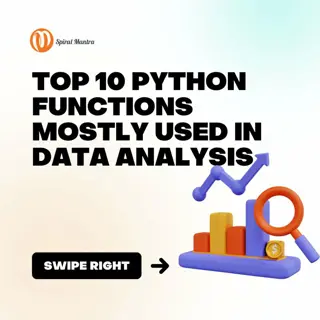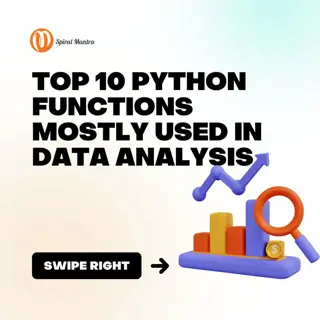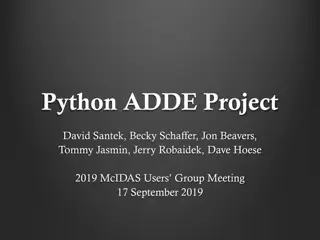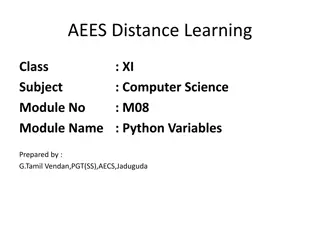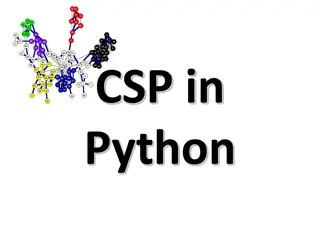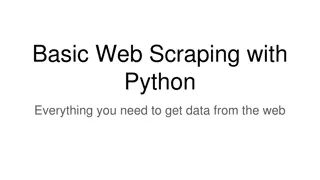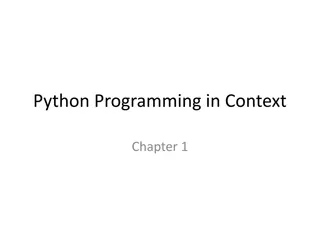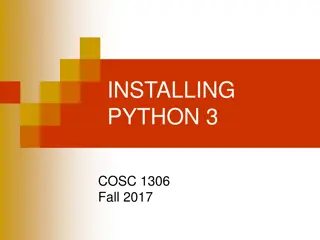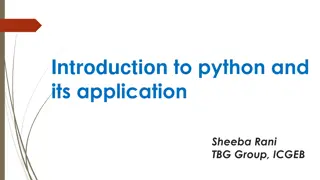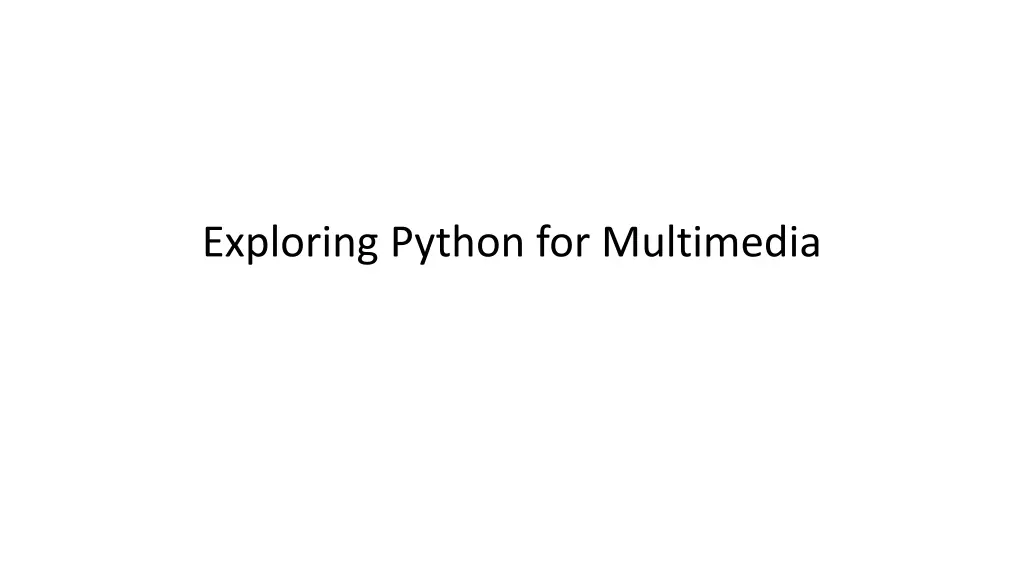
Python for Multimedia: Tools, Techniques & Advantages
Explore the versatility of Python in multimedia applications including image processing, audio analysis, and video editing. Learn about key advantages, image manipulation capabilities, comparison with JavaScript, and popular multimedia libraries like PIL/Pillow and OpenCV.
Download Presentation

Please find below an Image/Link to download the presentation.
The content on the website is provided AS IS for your information and personal use only. It may not be sold, licensed, or shared on other websites without obtaining consent from the author. If you encounter any issues during the download, it is possible that the publisher has removed the file from their server.
You are allowed to download the files provided on this website for personal or commercial use, subject to the condition that they are used lawfully. All files are the property of their respective owners.
The content on the website is provided AS IS for your information and personal use only. It may not be sold, licensed, or shared on other websites without obtaining consent from the author.
E N D
Presentation Transcript
Introduction Python is a versatile programming language widely used for multimedia applications. From image processing to audio analysis and video editing, Python provides powerful tools for working with digital content. Its ease of use and rich ecosystem of libraries make it an excellent choice for multimedia projects.
Why Use Python for Multimedia? Python stands out in multimedia development due to several key advantages: Ease of Use:Python s syntax is designed for readability, making it accessible to beginners. Rich Ecosystem: Numerous specialized libraries simplify multimedia tasks. Cross-Platform Compatibility: Python runs on various operating systems, making multimedia projects adaptable. Integration Capabilities: Python can be used alongside other technologies, enhancing multimedia workflows.
Working with Images Python is commonly used for image processing and manipulation. It enables tasks such as: Resizing and Cropping: Adjusting image dimensions. Filtering Effects: Applying enhancements like sharpening or blurring. Format Conversion: Changing image file types. Automated Editing: Batch-processing images efficiently. These capabilities are useful in photography, digital art, and computer vision applications.
Key Multimedia Tools: Python vs. JavaScript Python and JavaScript each provide powerful libraries for working with images and graphics. Here s a quick overview of their most commonly used tools: Python Multimedia Libraries PIL/Pillow A widely used library for image processing. It allows users to open, edit, and save images in various formats with simple commands. OpenCV A computer vision library that helps with image analysis, object detection, and facial recognition. Pygame A game development library that provides tools for drawing graphics, handling animations, and managing interactive elements.
JavaScripts Canvas API Canvas API A JavaScript tool for drawing graphics directly in a web browser, supporting both 2D and 3D rendering. Unlike Python, which focuses on image file manipulation, Canvas is designed for interactive, pixel-based drawing on webpages. Each tool is built for different purposes Python excels at automation and image processing, while JavaScript s Canvas is ideal for real-time, web-based graphics.
Feature Python (with Libraries) HTML5 Canvas/JavaScript Drawing Method Image-based processing (files, arrays) Direct pixel manipulation on a canvas Image Drawing in Python vs. HTML5 Canvas Primary Library PIL/Pillow, OpenCV, Pygame Canvas API in JavaScript HTML5 Canvas allows developers to draw graphics directly onto a webpage using JavaScript. Python approaches image drawing differently: Use Cases Image editing, AI, automation Web-based interactive graphics Animation Possible but less common Built-in support for dynamic animations
While Canvas is great for interactive real-time graphics in browsers, Python is used for static image manipulation and complex processing.
Drawing Images in Python Python has multiple libraries for creating and modifying images, including: PIL/Pillow Works with image files to apply filters, transform colors, and add text. Pygame Popular for game development, allowing direct drawing onto a surface. OpenCV Used for image analysis and drawing shapes in computer vision applications. Matplotlib Often used to generate plots and figures, which can be saved as images. These tools let Python manipulate images efficiently without needing direct canvas rendering.
Audio Processing Python is also widely used in audio analysis and modification. Key features include: Reading and Writing Audio Files: Handling formats such as WAV and MP3. Analyzing Audio Data: Extracting features like pitch and tempo. Visualizing Sound: Creating waveforms or spectrograms. Enhancing Audio: Applying effects and filtering techniques. These functions are beneficial in music production, speech recognition, and sound design.
Video Processing Python supports video analysis and editing, helping professionals and researchers in: Frame Extraction: Breaking down videos into individual images. Object Detection: Identifying elements within a video. Video Editing: Modifying and combining footage. Automated Processing: Streamlining workflows for large-scale video projects. These tools are widely used in film production, content creation, and artificial intelligence research.
Pythons Role in Multimedia Innovation Python enables groundbreaking applications in multimedia technology, including: Data Analysis for Multimedia: Identifying patterns in images, audio, and video. Scientific Research: Studying multimedia in fields such as linguistics, medicine, and art restoration. Machine Learning Applications: AI-powered tools for image recognition, voice synthesis, and video enhancement. Python continues to evolve, supporting new ways to create, analyze, and interact with digital media.
Conclusion Python provides a powerful set of tools for working with multimedia, offering a different perspective from HTML5 Canvas and JavaScript. While Canvas is excellent for interactive, web- based graphics, Python is strong in data-driven, analysis- focused, and automation-friendly multimedia applications. Understanding both approaches expands your ability to work with multimedia in diverse contexts.

